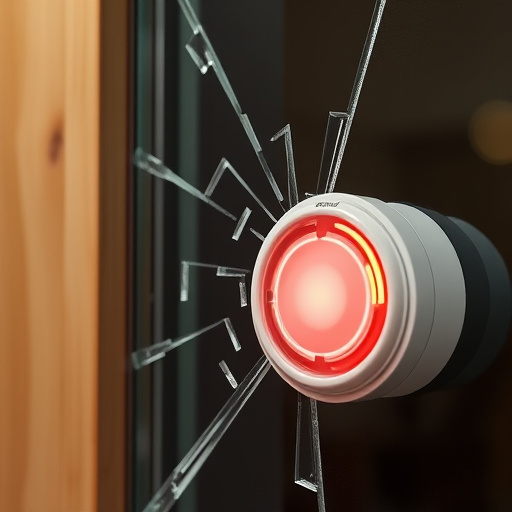Glass break alarm sensors, using sound wave & vibration monitoring, offer enhanced protection for areas with extensive glass paneling. Costs vary based on technology (e.g., PIR, acoustic wave), range, sensitivity, features, and installation complexity, with advanced models offering better performance. Installation involves professional setup & maintenance (initial $200-$1000, annual $50-$300 fees) and includes testing, battery replacement, and signal verification. Wireless sensors are user-friendly & affordable, while hardwired variants provide superior reliability & performance for commercial use. Market transformation driven by tech advancements & security awareness caters to diverse needs from basic to advanced.
“Uncover the cost of protection with a glass break alarm sensor—a critical component in home and business security. This comprehensive guide explores the factors influencing these sensors’ prices, from technology and installation to market trends. Learn how advanced features and unique applications impact costs, ensuring you’re informed when choosing the right glass break alarm for your needs. Discover the intricacies of these sensors and their role in enhancing security measures.”
Understanding Glass Break Alarm Sensors: How They Work
Glass break alarm sensors are advanced devices designed to detect and respond to broken glass, offering enhanced security for homes, businesses, and public spaces. These sensors operate by utilizing a unique combination of technology to monitor sound waves and glass vibrations. Typically, they consist of a microphone or sensor that continuously listens for sudden breaks in glass caused by noise or physical impact.
When a break is detected, the sensor triggers an alarm, alerting occupants or security personnel. The sensitivity and coverage area of these sensors can vary, allowing users to customize protection according to their specific needs. This technology is particularly useful for areas with large glass paneling, such as windows, doors, or glass partitions, where traditional alarms might not be as effective.
Factors Affecting the Price of Glass Break Alarms
The price of a glass break alarm, or its associated sensors, can vary greatly depending on several factors. One key determinant is glass break alarm sensor technology. Advanced sensors that use sophisticated noise analysis algorithms to distinguish shattering sounds from other ambient noises tend to be more expensive but offer superior performance and reliability.
Another factor is the alarm’s range and sensitivity. Longer-range alarms with adjustable sensitivity settings cater to a wider array of installation scenarios, necessitating additional components and technology, thereby increasing cost. Additionally, features such as wireless connectivity, battery backup, and integration with home security systems or smart homes add to the overall price point. Installation complexity also plays a role; intricate installation needs may require specialized skills, which can elevate labor costs.
Types of Glass Break Alarm Sensors and Their Cost Implications
Glass break alarm sensors come in various types, each designed for specific applications and offering different cost points. Passive infrared (PIR) sensors are among the most common types, detecting changes in infrared radiation to identify broken glass. They are relatively low-cost but may trigger false alarms due to their broad detection range. More advanced sensors like acoustic wave or shattering detectors use sound waves or microphone arrays to pinpoint the exact location of a break. These offer higher accuracy and better performance but come at a higher price point.
The cost implications for these sensors vary based on technology, sensitivity, range, and additional features. Basic PIR sensors can be purchased for as little as $20-$50 per unit, while advanced acoustic wave detectors can cost upwards of $200 each. When considering glass break alarm sensors, it’s crucial to balance the desired level of protection with your budget. Factors like installation complexity and additional wiring expenses should also be taken into account during decision-making.
Installation and Maintenance Costs: What You Need to Know
The cost of installing a glass break alarm system isn’t just about purchasing the device; it’s a comprehensive process that involves professional setup and ongoing maintenance. Installation costs can vary widely based on several factors, including the size and complexity of your property, accessibility for installers, and any existing security systems in place. Typically, you can expect to pay anywhere from $200 to $1000 for the initial installation, with annual maintenance fees ranging between $50 and $300 depending on the provider.
Regular maintenance ensures optimal performance of your glass break alarm sensors. This includes testing sensors, replacing batteries, and verifying proper signal transmission. Many providers offer contract-based maintenance plans that streamline these tasks, guaranteeing quick response times in case of false alarms or system malfunctions. By understanding these installation and maintenance costs, homeowners can make informed decisions about integrating a glass break alarm sensor into their security strategy.
Market Trends and Pricing Variations for Glass Break Alarm Sensors
The market for glass break alarm sensors has witnessed significant evolution, driven by advancements in technology and growing security concerns. These sensors, designed to detect shattering glass and alert homeowners or security systems, come in various types, each with unique features and price points. Wireless sensors, for instance, have gained popularity due to their ease of installation and integration with smart home platforms, making them a preferred choice for modern homeowners. On the other hand, hardwired sensors, though more expensive, offer enhanced reliability and robust performance, often favored in commercial settings or areas requiring high security standards.
Pricing variations for glass break alarm sensors can be attributed to factors such as technology type, range, detection capabilities, and brand reputation. Entry-level sensors typically cost less but may have limited features and smaller coverage areas. Premium sensors, conversely, offer advanced functionalities like motion detection, temperature monitoring, and wider ranges, making them more expensive. Additionally, specialized or custom-designed sensors for specific applications can command higher prices due to their tailored features and higher performance standards.
